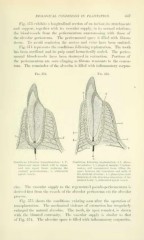Page 649 - My FlipBook
P. 649
BIOLOGICAL CONDITIONS IN PLANTATION. 647
Fitr. o73 exhibits a longitudinal section of an inrisor, its attachments
and support, together with its vascular supply, in its normal relations,
the bloodvessels from the pericementum anastomosing with those of
the alveolar periosteum. The pericemental space is filled with fibrous
tissue. To avoid confusion the nerves and veins have been omitted.
Fig. 574 represents the conditions following replantation. The tooth
has been sterilized and its pulp canal hermetically sealed. The perice-
mental bloodvessels have been destroyed in extraction. Portions of
the pericementum are seen clinging as fibrous remnants to the cemen-
tum. The remainder of the alveolus is filled with infiammatory corpus-
FiG. 575. Fig. 576.
Conditions following transplantation : 1, 1', Conditions following implantation : 1, 1, Alveo-
Embryonic tissue which will be organ- lar arteries ; 2, 2, gingival margin : 3, inflam-
ized into repair tissue replacing the matory still unorganized tissue filling the
original pericementum ; 5, obliterated space between the cementum and walls of
apical vessels. the artificial alveolus; 4, 4, phagocytes, mul-
tinucleated cells attacking cementum of im-
planted tooth ; .5, obliterated apical vessels.
cles. The vascular supply to the regenerated pseuclo-pericementum is
derived first from the vessels of the alveolar 2)eriosteum via the alveolar
process.
Fig. 575 shows the conditions existing soon after the operation of
transplantation. The mechanical violence of extraction has irregularly
enlarged the natural alveolus. The tooth, its a[iex rounded, is shown
Avith the blunted extremity. The vascular suj)j)ly is similar to that
of Fig. 574. The alveolar space is filled wdth infiammatory corpuscles.


